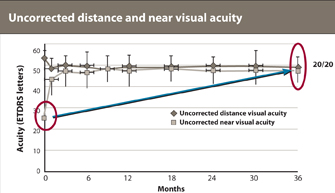Corneal inlay for treating presbyopia continues to show good results at 3 years
Researchers found that monocular implantation in the nondominant eye provides patients with gains in near and intermediate vision.
Results of a study investigating use of a corneal inlay for presbyopia correction in naturally emmetropic presbyopic patients demonstrated continued performance at 3 years.
The Kamra corneal inlay (AcuFocus) was implanted in the nondominant eye of 32 patients. After 36 months, the mean monocular uncorrected near visual acuity improved from approximately 20/70 to 20/25, and the mean monocular uncorrected intermediate visual acuity rose from 20/40 to 20/25. However, the mean monocular distance visual acuity decreased slightly to 20/20, with all eyes attaining at least 20/32. Mean binocular distance visual acuity was 20/16, with 91% achieving 20/16 or better.
“I am amazed how well the inlay works, if done properly,” study co-author Günther Grabner, MD, director of the University Eye Clinic at Paracelsus Medical University in Salzburg, Austria, told Ocular Surgery News.

Günther Grabner
Dr. Grabner performed all the surgeries included in the study, which was published in the Journal of Cataract and Refractive Surgery.
Small-aperture optics
The commercially available inlay design is 5 µm thick and consists of an opaque annulus that is 3.8 mm in total diameter, with a central aperture of 1.6 mm.
“Within this annulus, there are 8,400 laser-etched microperforations designed to allow for nutrient flow through the cornea,” Dr. Grabner said.
“[The inlay is] based on a simple but proven concept: small-aperture optics,” Dr. Grabner said. This optical principle, also known as the pinhole effect, was first used in photography.
“When patients become presbyopic, their lens is no longer able to assist with focusing light rays appropriately,” he said.
Through years of optical analysis and clinical investigation, Dr. Grabner and colleagues discovered that monocular implantation of a corneal inlay in the nondominant eye provides patients with approximately 2.5 D of depth of field.
“So unlike power-based approaches, patients gain near and intermediate vision with minimal affect on their distance vision,” Dr. Grabner said.
Study results
In the study, researchers used the prior-generation inlay design, which also measured 3.8 mm in total diameter with a 1.6 mm aperture. However, this inlay was 10 µm thick and had only 1,600 microperforations.
Nine inlay-implanted eyes (28.1%) lost one line of corrected distance visual acuity at 3 years, of which six were 20/20 or better and three were correctable to 20/25. One eye (3.1%) lost nearly four lines, falling from 20/16 preop to 20/32 at 3 years. However, no patient lost a line of binocular corrected distance visual acuity.

Source: Grabner G
The inlay technology and surgical procedure have evolved, and results with the commercially available inlay have improved, especially for corrected distance, the study authors said.
During the 3-year study period, no inlay was explanted, but two inlays had to be recentered at 6 months because of initial misplacement. Once the slightly decentered inlays were recentered, both patients reported a significant increase in visual acuity.
A third patient developed flap striae after 1 month, followed 2 months later by interface epithelial ingrowth. The patient was successfully treated, and at final follow-up uncorrected distance visual acuity was 20/20, intermediate was 20/32 and near was 20/25.
Overall, the corneal inlay may be considered a safe treatment option, Dr. Grabner said.
“With the development of the femtosecond laser and pocket software, we are now able to reliably control the depth at which we implant the inlay and have the option to implant under a flap or in a corneal pocket,” he said.
Dr. Grabner also noted that removal of the inlay is a simple procedure, and all patients whose inlays have been explanted have returned to baseline.
Preserving stereoacuity
Because there is no loss of stereoacuity with the inlay, patients describe their vision as feeling more natural compared to contact lens monovision, he said.
“With monovision, they were constantly aware of the difference between eyes and found that they had a sweet spot for near and a sweet spot for distance, but distances outside of those zones were not as clear,” Dr. Grabner said.
Proactive management of the corneal healing response and ocular surface quality translates into reliable results with the inlay. However, the simple postop regimens for LASIK patients are inadequate for an inlay patient, Dr. Grabner said.
Still, the inlay is a good option for presbyopic patients, according to Dr. Grabner, who has implanted more than 100 inlays to date.
“Implantation is simple and can be combined with LASIK to correct additional refractive error,” he said. Moreover, because the inlay can be removed, future surgical procedure options are not restricted. – by Bob Kronemyer
Reference:
- Seyeddain O, Hohensinn M, Riha W, et al. Small-aperture corneal inlay for the correction of presbyopia: 3-year follow-up. J Cataract Refract Surg. 2012;38(1):35-45.
For more information:
- Günther Grabner, MD, can be reached at University Eye Clinic, Paracelsus Medizinische Privat-Universität, PMU, Universitätsklinikum, Müllner Hauptstrasse 48, A 5020 Salzburg, Austria; email: g.grabner@salk.at.
- Disclosure: Dr. Grabner received travel expenses from AcuFocus Inc.
